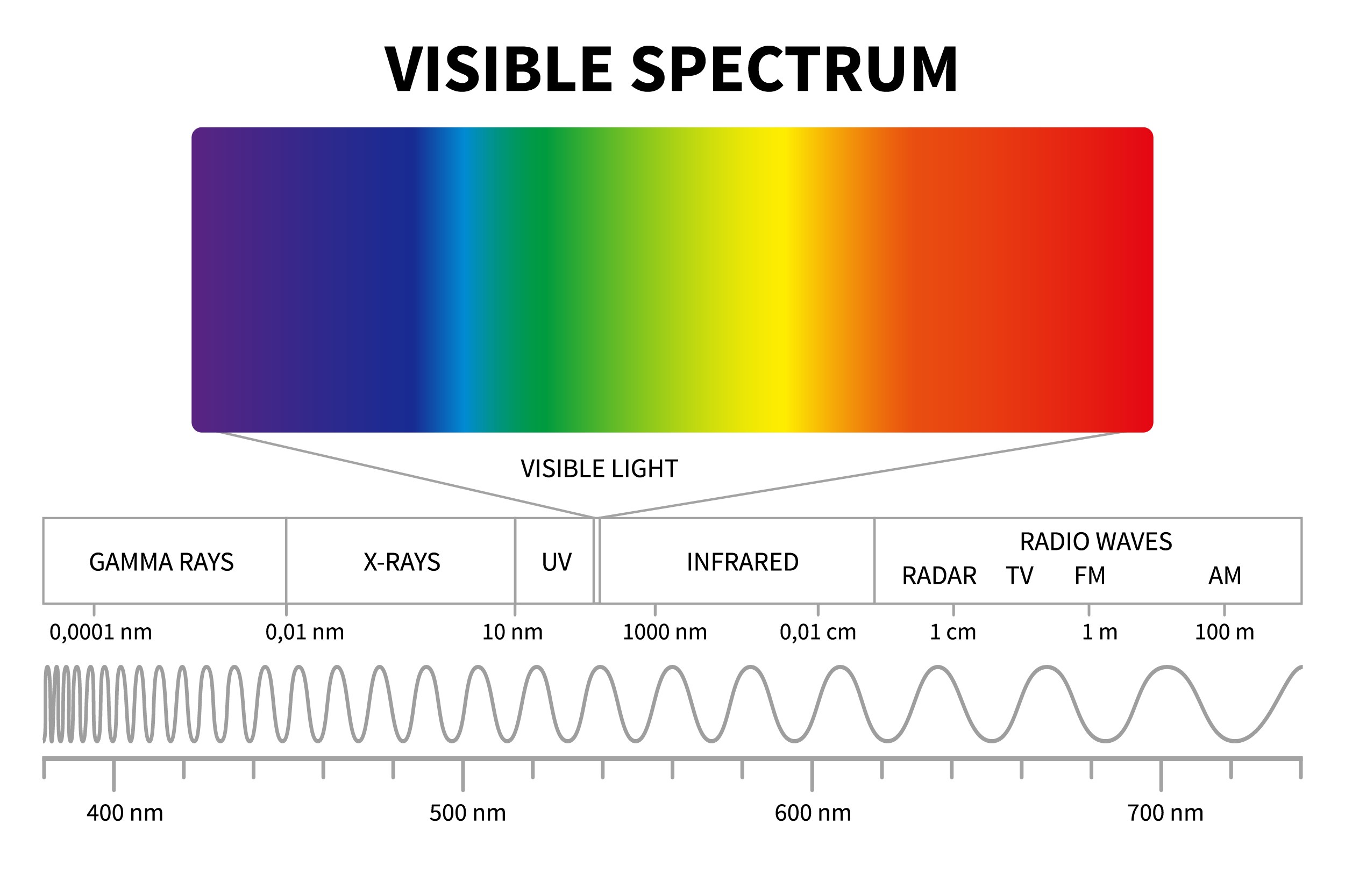On the same wavelength –
Radar frequencies, eligibility for approval, and bandwidth.
Sensors use electromagnetic waves to communicate. Radar units actively transmit high-frequency radio signals. Pulses from radar waves that spread freely at a certain frequency. When they hit an object, they then assess the echo to locate the target.
Just like radar, many other sensor technologies also use electromagnetic waves, but they exhibit different physical properties. LIDAR or infrared, for example, use different wave ranges than radar.
The following figure provides an overview:

© MicroOne by adobe stock
Frequency, bandwidth, frequency band?
When you delve into radar technology and the frequency ranges, you will encounter various terms. Since the terms come up frequently in this article and are important for operating radar units, you will find a brief explanation of the terminology below.
A frequency is the number of oscillations of electromagnetic waves. It describes the repetitions that occur during the propagation of the wave. The wave oscillates constantly (continuous oscillation). The faster the succession of repetitions, the higher the frequency.
The wavelength is directly related with the frequency. It is the distance between two successive wave peaks.
A frequency band, in turn, is a subset of the available frequency spectrum and spans a large number of frequencies. These individual frequencies are grouped into bands based on having the same or similar propagation characteristics.
The bandwidth, on the other hand, is the difference between the upper and lower frequency of a frequency band. It is limited by the two limit values of the allotted frequency band. And it determines in which frequency range the electromagnetic waves can spread and move. The bandwidth thus determines the frequencies in which a radar unit can send and receive signals. The broader it is, the more individual frequencies are available for this.
The radar frequency
Radar sensors use only a certain spectrum of electromagnetic waves – the microwave range from 30 megahertz to 300 gigahertz. And the sensors are further subdivided according to frequency, wavelength, and usage. These sub-ranges are also called frequency bands. The classification is determined by international institutions with the aim of achieving uniform designations for radar types. The frequency bands are thus assigned to specific letters. Originally, the designation systems were used to keep the frequency used secret and to ensure undisturbed communication. This was especially common in military use.
Even though the field of application of radar has expanded considerably over time, the classification has been maintained. The most commonly used designation systems are those of the international professional association IEEE (Institute of Electrical and Electronics Engineers) and the international organisation NATO. In product descriptions, many radar manufacturers indicate the letter of the corresponding frequency band instead of the frequency itself.
Note: InnoSenT generally specifies both the GHz and the frequency band of its products.
Operation of radar units in accordance with regulations
In addition to the designation of frequencies, the use of radar waves is subject to strict regulations by individual countries and coalitions of countries. Health protection plays an important role here. The transmitting power of sensors is adapted to the application and the possible danger.
Communication is also regulated in order to achieve even utilisation of the frequency. A special selection of frequencies is available for certain uses. This is determined mainly based on the physical suitability (achievable range and accuracy) for the respective application. In addition, it enables disturbances and overloads to be avoided despite increasing use of radar technology. All equipment that transmits and receives electromagnetic waves must be licensed. Different regulations must be taken into account depending on the sales region and production location.
Most important regulations
The regulations affect product characteristics such as frequency, frequency band, transmission power, frequency tolerance, bandwidth allocation, and frequency spectrum (e.g. out-of-band emissions).
High frequency vs low frequency
Higher frequencies have shorter wavelengths. Lower frequencies have longer wavelengths. These properties impact various parameters of radar waves: the range, bandwidth, and penetration.
With the same transmission power (or signal strength), longer wavelengths generally leading to a longer range. To put it simply, the higher the frequency, the shorter is the range. More information about the influences on the range, you can read more here.
If radar waves encounter obstacles such as people, pillar or vehicles, they are shaded or bent. In addition to the material properties (dielectric constant), these effects influence the penetration of materials. Bending happens when obstacles are smaller than the wavelength. Shading occurs when obstacles are larger than the wavelength.
Another effect is the attenuation. For example, the obstacle is a wall.
Then the wavelength behaves at lower or higher frequency as followed: In comparison, at 24 GHz the waves are more attenuated when they hit walls than at 10 GHz radars.
10 GHz radars (low frequency) have long waves that bend around obstacles and penetrate walls (smaller than λ=30mm wavelength). On the other hand, for 24 GHz radars (higher frequency and short waves), thin walls (larger than the wavelength λ=12.5mm) are difficult to penetrate.
Shorter wavelengths positively impact product design, as they allow smaller antenna dimensions. Starting from 60GHz, the sensors are very compact despite their extensive functionality. More complex radar applications require multiple antennas at 24GHz to achieve better resolution. This increases the size of the product.
Higher frequencies also enable larger bandwidths. And this presents an advantage in terms of radar units’ resolution. The distance resolution is much better. However, the design is often more complicated and expensive due to the components and tolerances.
24GHz, 60GHz, 77GHz… ?
Depending on individual product requirements, developers have to consider these characteristics to determine which frequency is best for later use. The choice is further restricted by the allocated application of the frequency bands as prescribed by law. Thus, beyond affecting characteristics such as the transmission power, the regulations also dictate the intended use. Even the allocation of applications to specific bands varies from country to country.
Typical frequency bands for radar applications
Avoiding interference
Due to the numerous national regulations and different assignments of applications to certain frequencies, developers need to know in advance exactly for what purpose and in which field of application the radar unit is to be used. As a result, radar equipment companies usually have a very large variety of products. For each sales region, there is a different certification and a product specially adapted to the respective regulations.
The aim of the classification is to avoid interference between several applications used at the same time. Especially for those areas where system reliability plays a major role. Driver assistance systems, vital sign monitoring, safety and security applications must not interfere with each other.
Nevertheless, in practice, different applications using the same frequency come together. For example, there is also a broad array of sensors integrated inside vehicles, and even traffic monitoring uses radar technology. The multitude of sensors in our everyday life must not cause trouble with each other, even when using the same frequency band.
To avoid this, radar developers utilise complex modulation forms (e.g. spread spectrum, pseudo-noise) or synchronise the radar with a GPS time reference, for instance. The radar units then do not transmit at the same frequency or do so only briefly. They also employ advanced algorithms in signal analysis to clean up the measurement results. This way, systems filter out disturbances.
Share this Content
Get this technology on your radar
Information on this advanced sensor technology
The demand for sensors is increasing due to trends such as digitalisation, automation in industry & logistics, smart homes & cities, and autonomous driving. But the development and integration of radar units is a complex topic, and the technical terms and functions raise many questions for users. Our radar experts have put together comprehensive information to help you get started in the world of radar.


